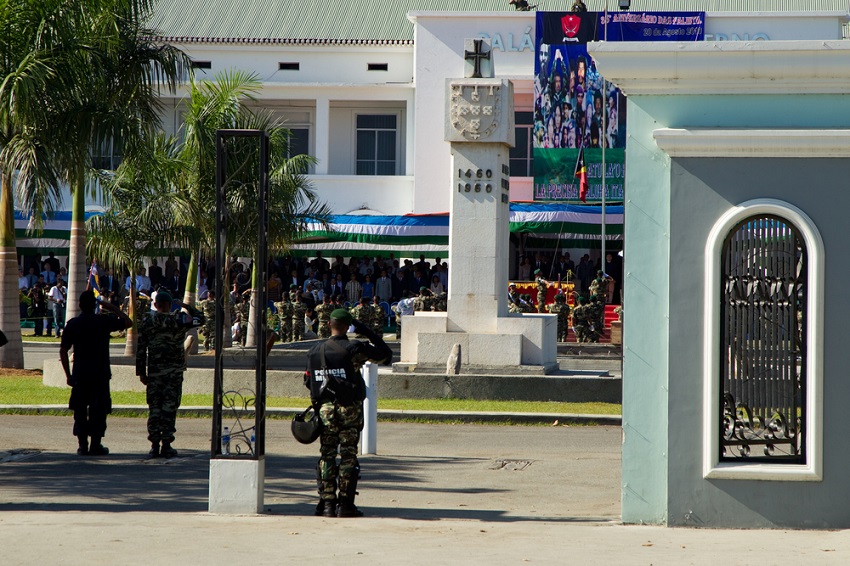Timor-Leste - history
Confusion might arise when this newborn country has officially adopted Timor-Leste after East Timor. The form changed, the meaning stays, though. Leste is a Portuguese word meaning East. The official name lays a trail back to when colonialism was thriving in Southeast Asia. Portugal and the Netherlands signed the Sentencia Arbital agreement in 1915 (สิทธา เลิศไพบูลย์ศิริ และ อรพรรณ ลีนะนิธิกุล,ผู้แปล, 2555:91) on dividing Timor Island into two parts. The eastern part ruled by Portugal was East Timor or today’s Timor-Leste while the western part rule by the Netherlands was West Timor.
Timor-Leste under Portuguese rule
The Portuguese had travelled to Timor Island in 1518 with a record describing “it is filled with white sandalwood that the Moors in India and the Persians deem valuable there.” (สิทธา เลิศไพบูลย์ศิริ และ อรพรรณ ลีนะนิธิกุล,ผู้แปล, 2555:71) Later in 1566, a group of Catholic missionaries came in and built forts on the island as inspired by the sandalwood, one of the economic crops preferred by the Westerners (Andrea Katalin Molnar, 2010:28). The Portuguese having settled there married the native. Their biracial descendants were “Topasses” or “the Black Portuguese”.
During the 17th-18th Century, the Portuguese was inflicting violence in trying to occupy the island because of the sandalwood and other natural resources. The land there was so ample it enabled all-year cultivation in which alternate cropping like rice, corn, tapioca, yam bean, sweet potato and other fruits took place in order to maintain the soil conditions. In addition, the native domesticated animals such as pig, goat, sheep and buffalo on hillside (สิทธา เลิศไพบูลย์ศิริ และ อรพรรณ ลีนะนิธิกุล,ผู้แปล, 2555:79).
Timorese administrative structure at that time was a relative bond considered so strong that the Portuguese was not able to break it. Thereby, the late 18th century policy of Portugal aimed at breaking the relative bond in that local area while building a foundation serving benefits to Portuguese economic. Levying labors to construct the roads helping facilitate goods transportations resulted in a stir among the native. It led to violence against the colonizer for the next 16 years claiming a great number of Timorese lives and properties. However, Timor-Leste was going to continue living under the Portuguese rule. It was not until the Second World War when Japan invaded and set up their bases.
Portugal attempted to occupy the island again after Japan had withdrew. The revolution against the military-led dictatorial government of Portugal broke out in March, 26 1974. In addition, other Portuguese colonies were warring against the government claiming thousands of Portuguese lives. Therefore, the new-yet-vulnerable Portuguese government carried out a policy granting independence to its colonies including East Timor. The Timorese general election was held, and Revolution Front for an Independent East Timor (FRETILIN) was elected. On 28th November 1975 FRETILIN formed a government and declared the country’s official name responding to its administration as Democratic Republic of Timor-Leste (วัชัย ตันติวิทยาพิทักษ์ และ สรณรัชฎ์ กาญจนะวณิชย์, 2543: 86). Nonetheless, it was not legitimized as a state nor recognized as an independent sovereignty by United Nation so that Indonesia was trying to intervene and send troops to occupy the island.
Timor-Leste under Indonesian Rule
Though achieving independence from Portugal that had been trying to occupy and colonize this land for 400 years earned Timor-Leste the general election and its own government, Indonesia could never rest trying to intervene Timorese internal affairs for that it would include the island as part of Indonesia. Feeling threatened Timor-Leste would eventually become communist due to political context at that time when the whole world was fearing for the communist expansion, Indonesian forces decided to occupy the island on 7th December 1975. It took 24 years until 1999 for the struggling and suffering of the Timorese. The Indonesian forces violently put down the Timorese resistant groups causing death and injuries of approximate 200,000 lives. The crackdown was getting so violent that FRETILIN turned to guerilla warfare setting up bases in the forests fighting against the Indonesian forces.
Timor-Leste and the Fight for Independence
When the Indonesian forces occupied Timor-Leste on 7th December 1975, it caused a great loss claiming Timorese lives and properties. The mass murder, burning down residential areas and shooting domesticated animals took place. Over 200,000 people died while a large number evacuated to West Timor. The prominent figure in the struggle for independence, Xanana Gusmao, the leader of FRETILIN, struck back at the Indonesian forces with guerrilla warfare and weapons, while the fight outside the country was sparked by Ramos Horta, who initiated a movement and asked for help from United Nation or any ways he could.
The struggle for independence in Timor-Leste divided the people into 2 groups. FALINTIL or The Armed Forces for the National Liberation of East Timor is the armed forces of FRETILIN, being founded in 1974 in order to fight against Portugal and Indonesia. This group was fighting for independence. On the other hand, MILITIA was a counter-fight armed group trying to claim Timor-Leste as part of Indonesia. The Indonesian army along with a group of Timorese founded MILITIA for that it would report the opponent moves. This prolonged fight ended in 1998 when Suharto relinquished his presidency. B.J Habibie proceeded (วัลลภ พิริยวรรธนะ, 2558:13-14).
B.J Habibie gave an interviewed on 9th June 1988 that Timor-Leste earned the autonomous privilege, yet remained protected by Indonesia. A popular referendum was held on 30th August 1999 when 98% of Timorese population showed up and voted. As a consequence, 78% demanded independence upsetting the MILITIA who inflicted violence on 20th September 1999. United Nation had to send international forces in order to take control of the situation and solve problems regarding human right violations (วัลลภ พิริยวรรธนะ, 2558:13-14).
Timor-Leste after the Declaration of Independence
After regaining independence from Indonesian invasion, Timor-Leste is taking time to recover the country and improve the quality of life. The natural resources were burned down by the Indonesian forces during the time of the struggle for independence. It aimed at destroying and putting down the FRANTILIN, whose guerilla bases had been hidden in the forests. A large number if a gricultural-devoted land pieces and economic crops like sandalwoods were destroyed.
The key political leader, Xanana Gusmao, became the first president of the independent Timor-Leste. He recognized a profound importance of the nation’s unity and also was aware of the MILITIA, who, in the past, had mounted resistance laying obstacles on the way to independence. Now, Timor-Leste is a newborn country in Southeast Asia, and is trying to apply for the 11th ASEAN member country. It is committed to continue improving the quality of life for the people. The present president is Taur Matan Ruak.
Bibliography
Andrea Katalin Molnar. (2010). Timor Leste. Newyork: Routledge.
วันชัย ตันติวิทยาพิทักษ์ และ สรณรัชฎ์ กาญจนะวณิชย์. (มีนาคม 2543). ก่อนกำเนิดติมอร์ตะวันออก โฮเซ่ รามอส - ฮอร์ต้า. สารคดี, 16(18), 82-92.
วัลลภ พิริยวรรธนะ. (มกราคม-มิถุนายน 2558). กว่าจะเป็นติมอร์ - เลสเต (ติมอร์ตะวันออก) วันนี้. เอเชียพิจาร, 2(3), 119-165.
สิทธา เลิศไพบูลย์ศิริ. (2555). ติมอร์ตะวันออก : เส้นทางสู่เอกราช. (อรพรรณ ลีนะนิธิกุล, ผู้แปล) กรุงเทพมหานคร: มูลนิธิโครงการตำราสังคมศาสตร์และมนุษยศาสตร์.


